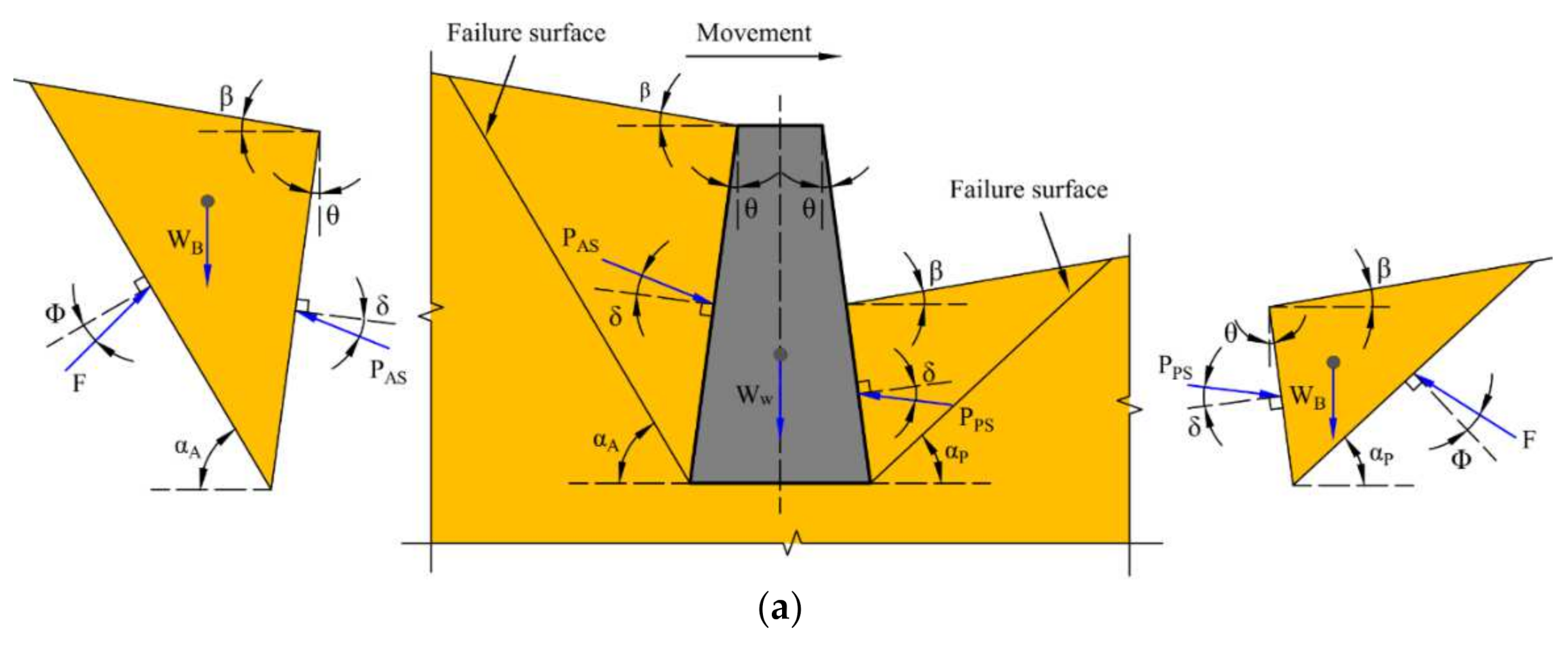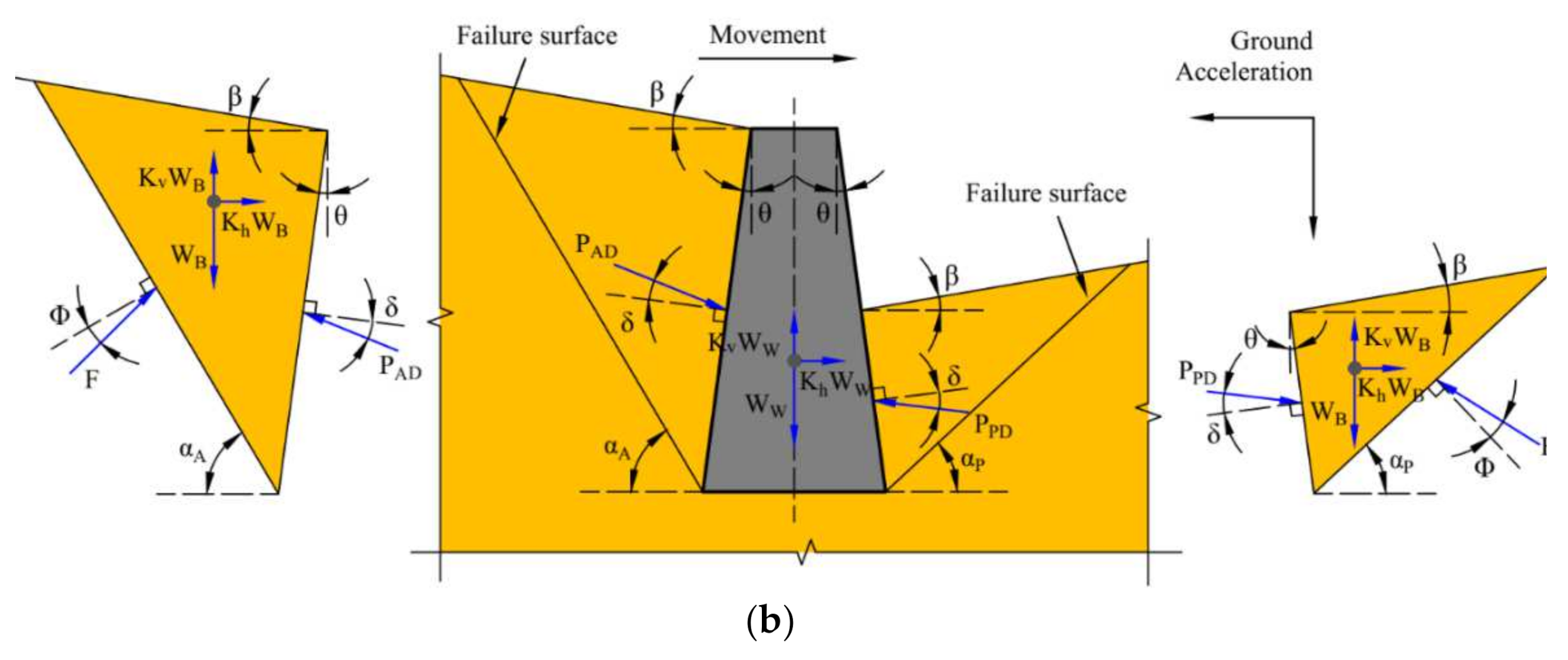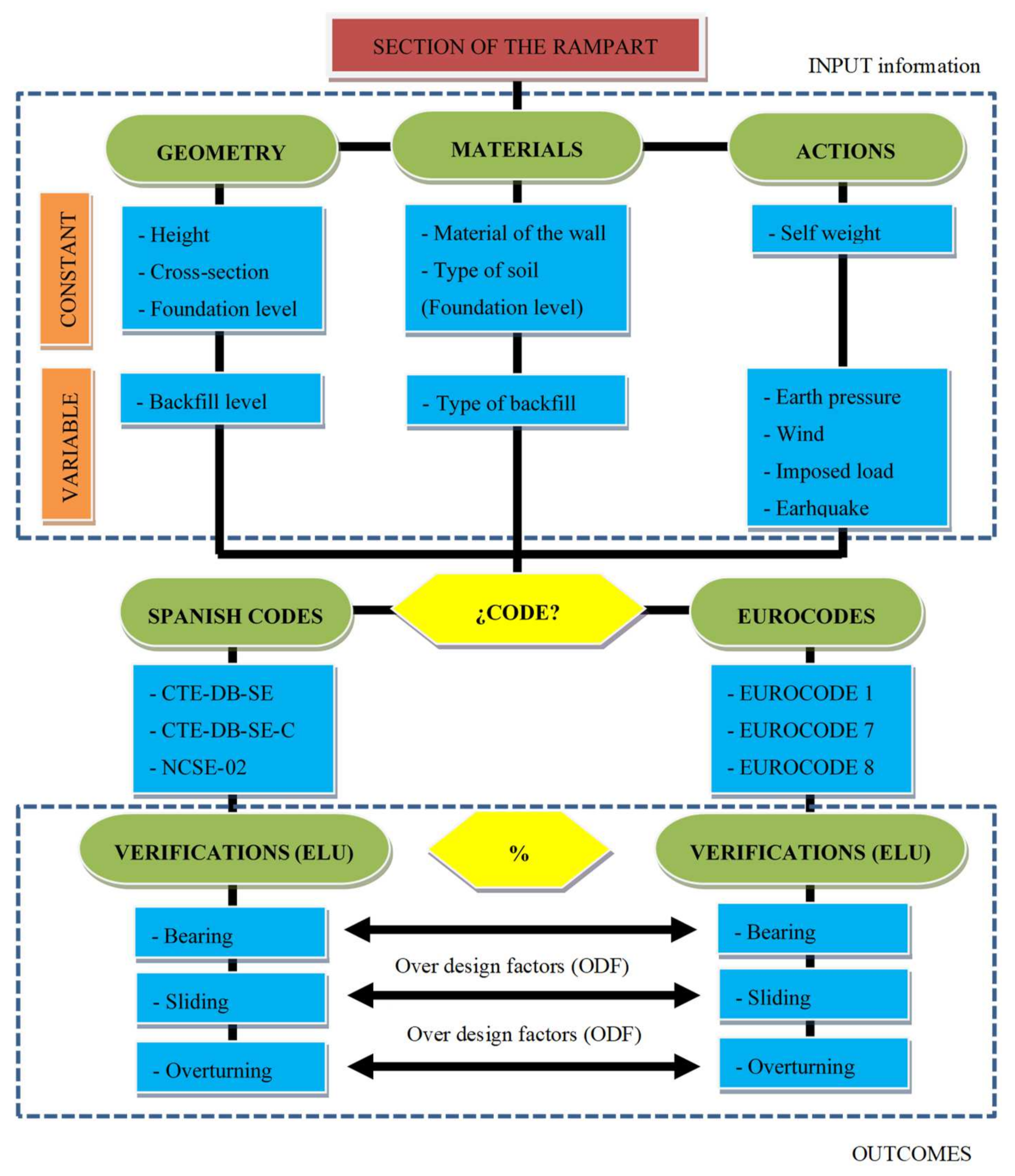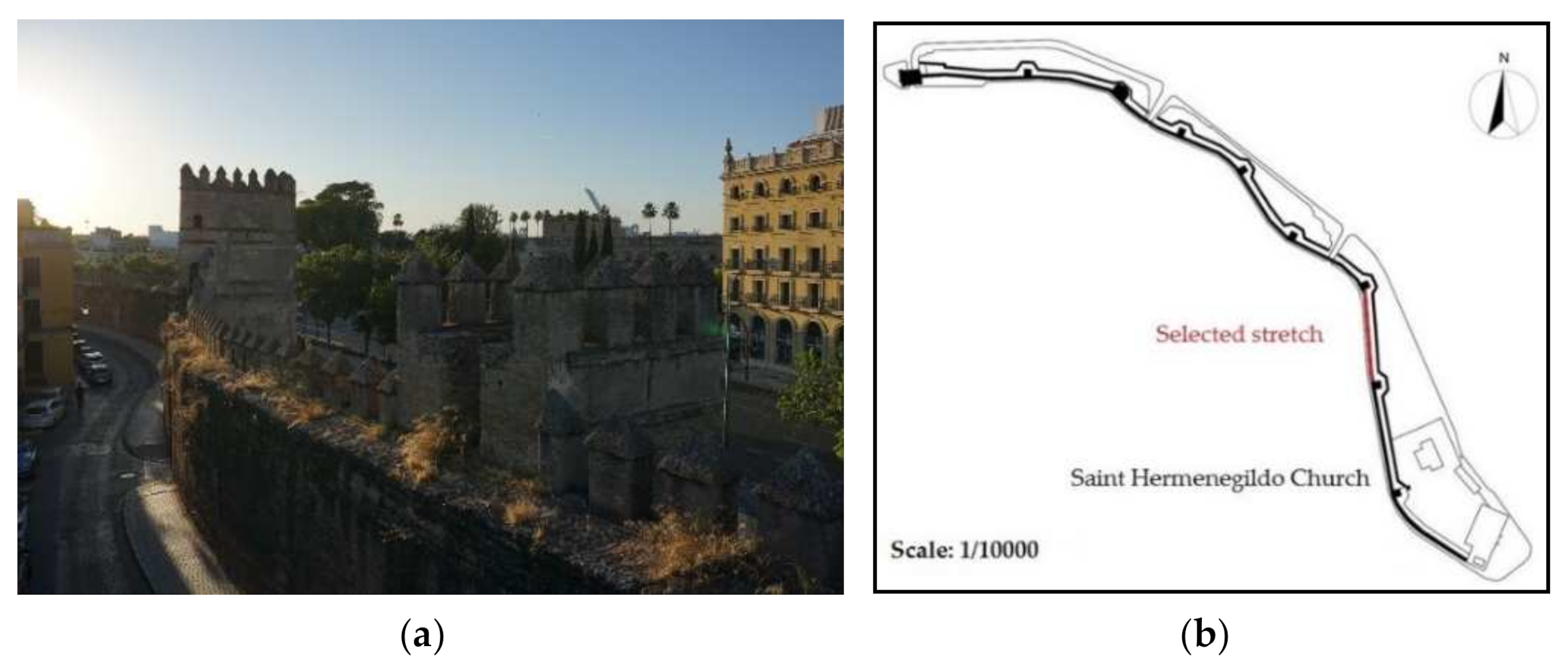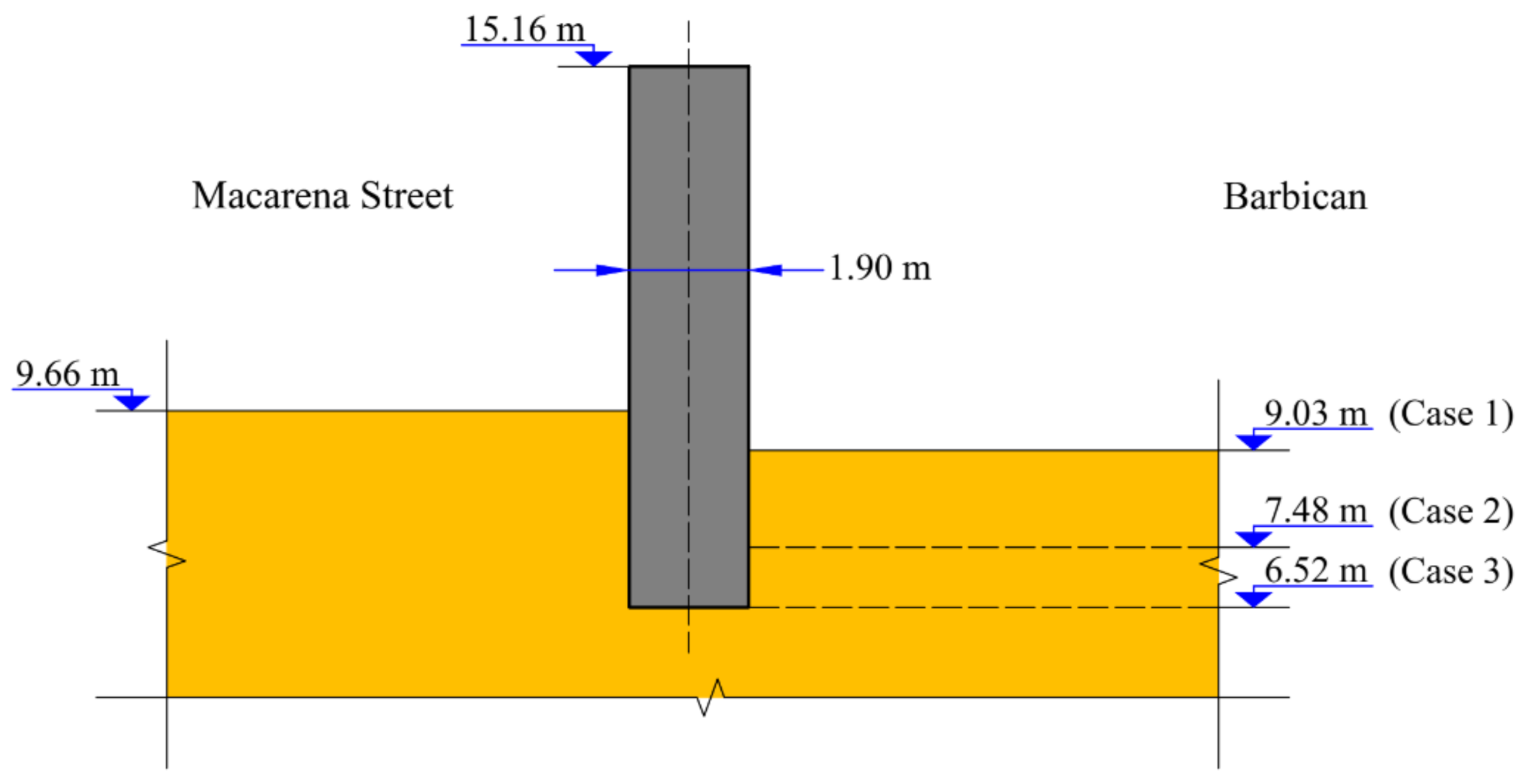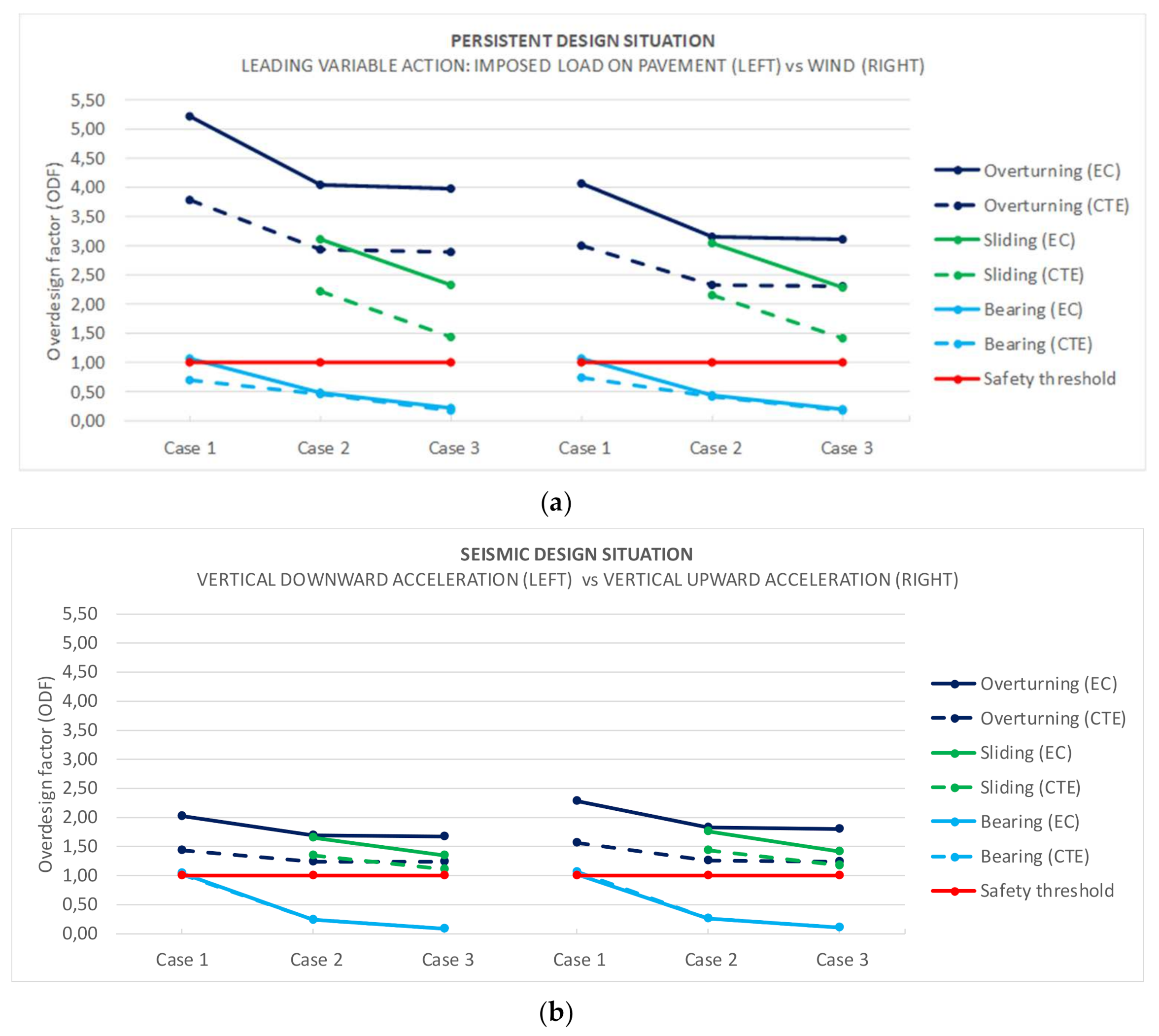For geotechnical verifications, several actions have been considered, namely: self-weight of the structure, the lateral earth pressure from the backfills, a uniform surcharge loading over the backfill, the wind, and the effect of a possible seismic event. The weight of the structure is directly determined by multiplying the density of the wall by its cross-sectional area. However, the magnitude of the rest of the forces acting on the structure is not straightforward to estimate and will be discussed in detail hereafter.
2.4.1. Lateral Earth Pressure
Checking the lateral pressure from the backfill, two methods have been considered among the possibilities currently available [
27]: the Coulomb method (
Figure 1a), in case of static conditions, and the Mononobe-Okabe method (
Figure 1b) for dynamic conditions from seismic events.
Because friction between the wall and the soil is considered, Coulomb’s theory is applied in order to determine the resultant force (
) in case of active earth pressure (
Figure 1a). This method assumes that the failure surface is two-dimensional and passes through the heel of the wall, whose inclination to the horizontal plane (
) is unknown. This failure plane in conjunction with wall surface closer to the backfill defines a wedge of soil, which can slide over these two planes [
28]. For this particular case of active earth pressure, this wedge moves away from the backfill and downward. By posing the equilibrium of this wedge as a rigid body in terms of the angle (
) and solving an optimization problem, a maximum value for
is obtained. The force obtained thereby is located at one-third of the height of backfill from the bottom and acts at an angle (
) with the normal to the back of the wall, which ranges from 1/3 to 2/3 times the soil friction angle (
ϕ). The magnitude of this force is obtained by applying Equation (42), where
is defined by Equation (43).
In the case of the wall supporting a uniform surcharge (q), the resultant force (
) must also include the lateral earth pressure of the soil skeleton as a result of the imposed load. For this scenario, it is necessary to define a new value of unit weight for the wedge
to take the surcharge into account. Its magnitude can be obtained according to Equation (46):
By using Coulomb’s theory it is also possible to determine the magnitude of the resultant force (
) in case of passive earth pressure (
Figure 1a). In this case, the wedge defined by the horizontal plane (
) moves towards the backfill and upward. As previously, this force is located at one-third of the height of the backfill from the bottom and acts at an angle (
) with the normal to the back of the wall, taking a zero value. The magnitude of the resultant force is now obtained by applying Equation (47), where
is defined by Equation (48).
An estimation of the resultant force during earthquakes is performed using the Mononobe-Okabe method [
29,
30,
31], which is considered to be an extension of the above-mentioned Coulomb’s theory. Seismic loads are applied to the soil wedge by using a pseudo-static method, so that horizontal and vertical inertia forces are introduced into the model using coefficients (
Figure 1b). The horizontal component of the inertia force is oriented away from the backfill, in order to obtain a greater value of the resultant force (
) in case of active earth pressure. According to the simplified procedure posed by Seed and Whitman in 1970 [
32], this dynamic force can be decomposed into the sum of the static case and a force increment, as shown in Equation (49). The seismic increment component is determined by using Equation (50), where
is defined by Equation (51).
It should be considered that high values for the inclination angle of the backfill surface from the horizontal line may result in a negative value for the square root term in Equation (51). Consequently, parameter would be expressed in terms of complex values. In this situation, the term in brackets of this expression is forced to be 1 to work with real numbers.
By applying this method, the total magnitude of seismic active force is determined. However, even though some research has been carried out, its point of application is not straightforward. EC8-5 states that this force increment is located at mid-height of the backfill, whereas NCSE-02 sets its location at 2/3 of the height from the foundation plane. Static and dynamic components are orientated in the same direction and act at an angle () with the normal to the back of the wall.
Similarly to the procedure described for the dynamic active case, Towhata and Islam in 1987 [
33] developed a simplified procedure to determine the resultant force (
) in case of passive earth pressure. Among the main hypotheses considered, the following should be highlighted: vertical wall (
), granular horizontal backfill (
), and no friction between the soil and the retaining wall (
). The seismic increment component is determined using Equation (53), where
is defined by Equation (54). Static and dynamic components are orientated in the same direction and act at an angle (
) with the normal to the back of the wall. No information about the point of application of force increment is considered in the codes, so it is assumed to be the same considerations as in the active case.
Comparing Equations (43), (48), (51), and (54) it is obvious that a new parameter
is introduced, whose value is determined by employing Equation (55), where
and
are the horizontal and vertical seismic coefficients, respectively.
The horizontal coefficient is obtained by Equation (56) and it depends on several factors, namely:
, the ratio of the design ground acceleration on type A ground
to the acceleration of gravity;
, the soil factor; and
, which is a factor that accounts for the type of retaining structure (taken from Table 7.1 of EC8-5). Conversely, the vertical coefficient is calculated more easily by multiplying the horizontal coefficient previously calculated by a constant according to Equation (57a,b).
According to Equation (58),
is calculated from the reference peak ground acceleration on type A ground
and the importance factor
.
CTE-DB-SE estimates that seismic forces acting on the structure must be taken into account according to NCSE-02, which refers to the Mononobe-Okabe method to account for the seismic action on the retaining wall. It should be noted that its expressions are following EC8-5 but with a slight difference in the value of the horizontal seismic coefficient, which is calculated through Equation (59).
According to NCSE-02, design ground acceleration is obtained by Equation (60), where
is the basic seismic acceleration,
is a dimensionless risk coefficient (1.0 or 1.3 depending on the importance of the structure) and
is the soil amplification coefficient. The latter is obtained using Equation (61a–c), depending on the product of the two previous coefficients. These expressions include a new parameter C, called soil coefficient and its value ranges from 1.0 to 2.0.
2.4.2. Wind Action
Agreeing with the considerations of Rodriguez-León and Sanchez-Sánchez [
19], EC1 and CTE-DB-SE provide remarkably similar formulation approaches to determine wind action over structural elements. EC1 states that the wind pressure acting on an external surface
can be obtained from the Equation (62), where
is the basic velocity pressure,
is the exposure factor at the reference height and
is the pressure coefficient, whose value is based on the shape and geometry of the structure. Likewise, CTE-DB-SE calculates the wind pressure on an external surface (
) by Equation (64) using very similar factors as EC1, namely: the basic velocity pressure (
), the exposure factor (
) and the pressure coefficient
.
According to the first factor of Equations (62) and (63), the basic velocity pressure (
), is obtained by Equation (64), where
is the basic wind velocity and
is the probability factor, given by Equations (65) and (66), respectively; and
is the air density (recommended value 1.25 kg/m
3). Additionally,
is the directional factor,
is the season factor (set equal to 1 in both cases following recommendations) and
is the fundamental value of the basic wind velocity, whose value is specified in each National Annex. Additionally,
is the shape parameter depending on the coefficient of variation of the extreme-value distribution,
is a constant (their recommended values are 0.2 and 0.5, respectively) and
is the annual probability of wind velocity exceeding the fundamental value of basic wind velocity (expressed as the inverse of return period).
The exposure factor at the reference height
is obtained according to Equation (67). It should be noted that the numerator is known as the peak velocity pressure at the reference height
whereas the denominator is the basic velocity pressure introduced above. The terms
and
are the turbulence intensity and the mean wind velocity at the reference height
respectively, determined by Equation (68a,b) and (69) as appropriate. Additionally,
is the turbulence factor and
is the orography factor (their recommended values are (1); and
is the roughness length. Finally, a new parameter is introduced in this last expression, called the roughness factor
. Its value is obtained using Equation (70a,b), depending on the height reference, taking
at a value of 200 m.
According to Equation (64), CTE-DB-SE proposes that basic velocity pressure (
) is calculated by Equation (71), and the exposure factor
is obtained according to Equations (72) and (73), where
are parameters selected in accordance with the surroundings of the structure (Table D.2 of CTE).
